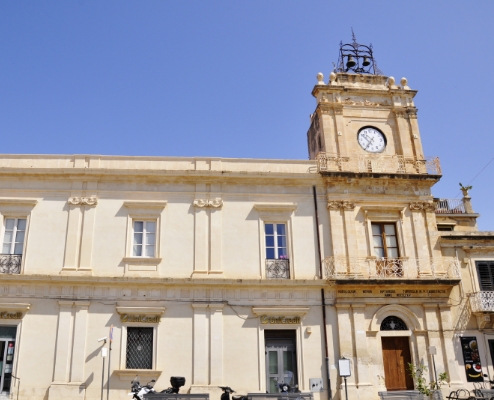The Clocktower and ‘Casa dell’Università’
1703; redesigned and built 1865-1866
Not open for visits.

In the ancient city of Avola, at the top of the settlement, there was the neighborhood of Suso with the Castle and the two towers. Just below, as historian Francesco Di Maria writes, there was a large square called dell’Orologio, with shops used for public markets. After the earthquake of January 11, 1693, the Clock and the bell that struck the hours were salvaged from the rubble and repaired. They were placed in a wooden loggia in the Piazza Maggiore (Piazza Umberto I) of the new city. In 1703, the magister Michelangelo Alessi built the Clock Tower in masonry. Located on the north side of the grand square, it was part of the Palace of Pignatelli Aragona Cortés, the marquises of Avola.
The building, known as Casa dell’Università, occupied the entire block and served as the administrative headquarters of the Marchesato di Avola, replacing the destroyed Castle. The rooms on the upper floor of the palace were reserved for the feudal lords, while the lower floor housed the archives, prison cells, and the torture chamber.
In the city, there was a need for a “four-register” clock that could strike not only the hours but also the quarters, noon, midnight, and the two-hour chime. This led to the decision to rebuild the clock. A second bell was added, and the construction was raised to better spread the sounds. The new clock was built in Avola by Corrado Alessi and was installed in 1777. The Tower suffered severe damage during the earthquake of January 11, 1848. After repairs, it required further adjustments. However, the two dammusi (underground chambers) below the Clock, along with the entire marquisal palace, had been sold to private individuals by Marquess Giuseppe Pignatelli Aragona Cortés in 1828.
In April 1860, it was decided to build a new clock and place it on the front of the Mother Church. After the Unification of Italy, the City Council decreed that the Clock should return to its original location. The ground floor of the Tower was acquired from the owner, Canon Giuseppe Di Maria, and in 1865, Mayor Calogero Gubernale approved the contract for its reconstruction. Filippo Spada, who came from Noto, built the mechanism, while architect Salvatore Rizza (Avola 1830-1895) designed and supervised the construction work, which was carried out in 1866 by master builder Paolo Restuccia using stone from the Straticò Quarry. The Clock Tower, in neoclassical style and consisting of three levels, features Doric capitals at the base, Ionic capitals on the first floor, and stylized capitals on the second floor. The latter level forms the facade of the chamber that houses the mechanism. Inside, the floor and staircase were made of pitchstone, while iron, crafted according to Rizza’s designs, was used for the railings of the two galleries and the support structure for the bells. The support structure is topped by a weathervane with a rooster indicating the cardinal points. The two bells still strike the hours and quarters, but they no longer mark the wake-up call in the morning (3:30 am), the school hour (8:00 am), lunchtime (12:00 pm), the two evening retreat hours (7:30 pm in winter, 8:00 pm in summer), or midnight.

Explore the historic center of Avola!
Welcome to Avola, the hexagonal city! Explore the historic center.
Explore the historic center of Avola!
Welcome to Avola, the hexagonal city! Explore the historic center.
